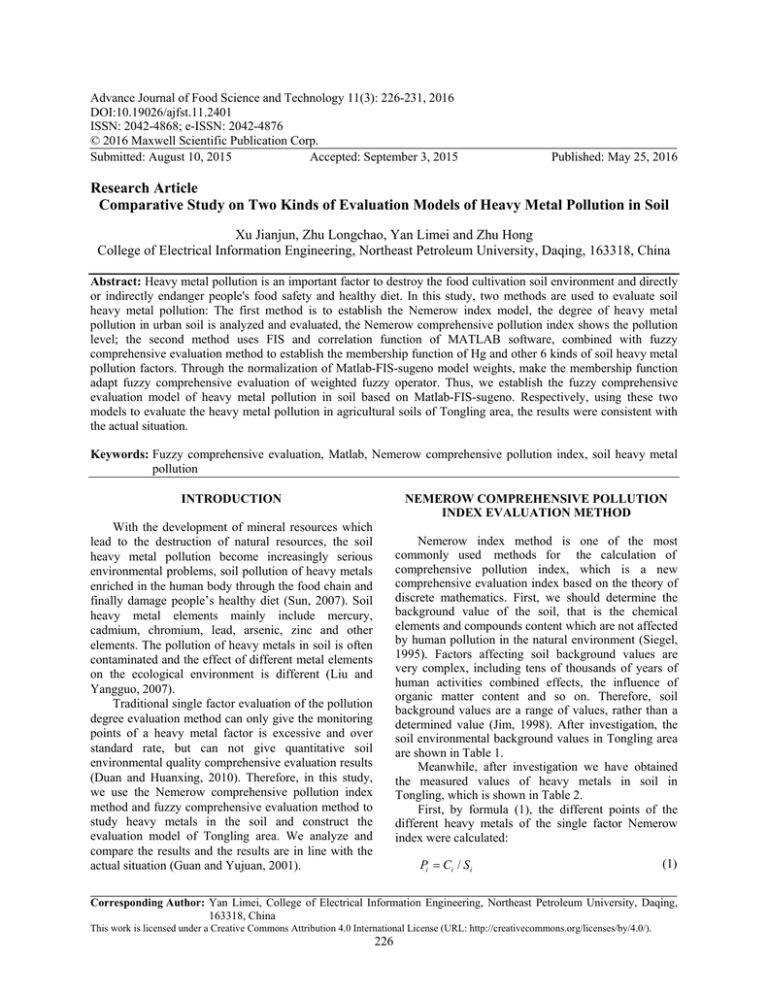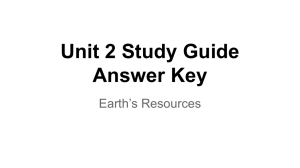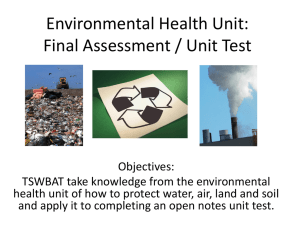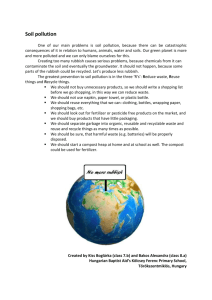Advance Journal of Food Science and Technology 11(3): 226-231, 2016 DOI:10.19026/ajfst.11.2401
advertisement

Advance Journal of Food Science and Technology 11(3): 226-231, 2016
DOI:10.19026/ajfst.11.2401
ISSN: 2042-4868; e-ISSN: 2042-4876
© 2016 Maxwell Scientific Publication Corp.
Submitted: August 10, 2015
Accepted: September 3, 2015
Published: May 25, 2016
Research Article
Comparative Study on Two Kinds of Evaluation Models of Heavy Metal Pollution in Soil
Xu Jianjun, Zhu Longchao, Yan Limei and Zhu Hong
College of Electrical Information Engineering, Northeast Petroleum University, Daqing, 163318, China
Abstract: Heavy metal pollution is an important factor to destroy the food cultivation soil environment and directly
or indirectly endanger people's food safety and healthy diet. In this study, two methods are used to evaluate soil
heavy metal pollution: The first method is to establish the Nemerow index model, the degree of heavy metal
pollution in urban soil is analyzed and evaluated, the Nemerow comprehensive pollution index shows the pollution
level; the second method uses FIS and correlation function of MATLAB software, combined with fuzzy
comprehensive evaluation method to establish the membership function of Hg and other 6 kinds of soil heavy metal
pollution factors. Through the normalization of Matlab-FIS-sugeno model weights, make the membership function
adapt fuzzy comprehensive evaluation of weighted fuzzy operator. Thus, we establish the fuzzy comprehensive
evaluation model of heavy metal pollution in soil based on Matlab-FIS-sugeno. Respectively, using these two
models to evaluate the heavy metal pollution in agricultural soils of Tongling area, the results were consistent with
the actual situation.
Keywords: Fuzzy comprehensive evaluation, Matlab, Nemerow comprehensive pollution index, soil heavy metal
pollution
INTRODUCTION
NEMEROW COMPREHENSIVE POLLUTION
INDEX EVALUATION METHOD
With the development of mineral resources which
lead to the destruction of natural resources, the soil
heavy metal pollution become increasingly serious
environmental problems, soil pollution of heavy metals
enriched in the human body through the food chain and
finally damage people’s healthy diet (Sun, 2007). Soil
heavy metal elements mainly include mercury,
cadmium, chromium, lead, arsenic, zinc and other
elements. The pollution of heavy metals in soil is often
contaminated and the effect of different metal elements
on the ecological environment is different (Liu and
Yangguo, 2007).
Traditional single factor evaluation of the pollution
degree evaluation method can only give the monitoring
points of a heavy metal factor is excessive and over
standard rate, but can not give quantitative soil
environmental quality comprehensive evaluation results
(Duan and Huanxing, 2010). Therefore, in this study,
we use the Nemerow comprehensive pollution index
method and fuzzy comprehensive evaluation method to
study heavy metals in the soil and construct the
evaluation model of Tongling area. We analyze and
compare the results and the results are in line with the
actual situation (Guan and Yujuan, 2001).
Nemerow index method is one of the most
commonly used methods for the calculation of
comprehensive pollution index, which is a new
comprehensive evaluation index based on the theory of
discrete mathematics. First, we should determine the
background value of the soil, that is the chemical
elements and compounds content which are not affected
by human pollution in the natural environment (Siegel,
1995). Factors affecting soil background values are
very complex, including tens of thousands of years of
human activities combined effects, the influence of
organic matter content and so on. Therefore, soil
background values are a range of values, rather than a
determined value (Jim, 1998). After investigation, the
soil environmental background values in Tongling area
are shown in Table 1.
Meanwhile, after investigation we have obtained
the measured values of heavy metals in soil in
Tongling, which is shown in Table 2.
First, by formula (1), the different points of the
different heavy metals of the single factor Nemerow
index were calculated:
Pi Ci / Si
(1)
Corresponding Author: Yan Limei, College of Electrical Information Engineering, Northeast Petroleum University, Daqing,
163318, China
This work is licensed under a Creative Commons Attribution 4.0 International License (URL: http://creativecommons.org/licenses/by/4.0/).
226
Adv. J. Food Sci. Technol., 11(3): 226-231, 2016
Table 1: Soil environmental background values in tongling mg/kg
Hg
Cd
As
Pb
Cu
Zn
0.05
0.09
12.44
47.81
32.15
85.58
Table 2: Heavy metal contant in soil mg/kg
Sampling point
Hg
Cd
As
1
0.071
1.22
16.9
2
0.076
0.14
11.2
3
0.071
1.12
21.5
4
0.108
0.67
14.9
5
0.096
1.11
17.9
Pb
81.2
23.2
74.3
91.3
80.5
Cu
76
28.3
81
76.9
71.5
Zn
136.5
58.8
136
188.6
195.5
Table 3: Single factor Nemerow index of heavy metals in soil mg/kg
Sampling points Hg
Cd
As
Pb
Cu
Zn
1
1.42
13.55
1.35
1.69
2.33 1.59
2
1.52
1.54
0.90
0.48
0.86 0.68
3
1.42
12.44
1.72
1.55
2.51 1.88
4
2.16
7.48
1.97
1.90
2.39 2.20
5
1.92
12.33
1.43
1.68
2.20 2.28
Table 4: Weight value of heavy metal pollution elements
Hg
Cd
As
Pb
Cu
3
3
3
3
2
Zn
2
Table 5: Nemerow comprehensive pollution index of different
sampling points
Sampling
point
1
2
3
4
5
Nemerow
9.9688
1.2978
9.1937
5.7326
9.1294
index
In the formula, Ci is the measured value of single
heavy metal content, Si is the soil environmental
background value. After calculation, the single factor
Nemerow index of different elements of 1-5 sampling
points are shown in Table 3.
As the single factor Nemerow index can not
accurately display the degree of land pollution, so we
use the comprehensive Nemerow pollution index to
evaluate:
n
Piavg
w P
i 1
n
i
(2)
w
i 1
Pi
i
i
2
Piavg
Pi 2max
2
(3)
In the formula,
Piavg = The weighted average of the single factor index
Pimax = The maximum value of single factor Nemerow
index
wi = The weight
= The Nemerow comprehensive evaluation index
Pi
The single factor index obtained by average value
is not accurate, so the average value can be improved
by using the weighted average. The weights are
classified as shown in Table 4.
After calculation, the comprehensive Nemerow
evaluation index of the 1-5 sampling points is shown in
Table 5.
According to the evaluation criteria of Nemerow
comprehensive pollution index, the sampling point 2 is
light pollution and the other sampling points are heavy
pollution, the evaluation results are consistent with the
actual results.
FUZZY COMPREHENSIVE
EVALUATION METHOD
With the deepening of environmental quality
assessment, the variables need to study are increasing
and becoming more and more complex. There are not
only the determined change rules, but also the random
change rules. The accuracy and fuzzy of the
environmental quality, determination and uncertainty
are all characteristic of quantity. So we use fuzzy
comprehensive evaluation method to evaluate the
degree of heavy metal pollution in soil. The so-called
fuzzy comprehensive evaluation method is the
application of fuzzy transformation principle and
maximum membership principle, it considers the
influence of the factors related to the things to be
evaluated. Therefore, the fuzzy evaluation model of
farmland soil in Tongling mining area is proposed by
using the FIS tool in MATLAB software and the model
is applied to evaluate the heavy metal pollution in
farmland soil in Tongling mining area (Lu and Lu,
2003).
First of all, we need to determine the factors to be
evaluated, this study established the factor sets of six
elements: Hg, As, Cd, Pb, Cu, Zn. Then we should
determin the standard values of the different factors and
set up the evaluation set. Because of the soil heavy
metal evaluation index has a certain regional, we refer
to the soil environment quality standard (GB151681995) and the Tongling city soil ring background value,
the soil heavy metal pollution is divided into five levels
(Zhang and Wang, 2003), as shown in Table 6.
Secondly, we should determine the weight set:
Si S1 S2 S3 S4 S5 / 5
(4)
C n C
W i i / i
S i i 1 S i
(5)
In the formula, Si is the average value of some kind
of pollutants and Ci is the measured concentration of
some kind of pollutants. After calculation, the grading
average values of six kinds of heavy metal pollutants
are shown in Table 7.
227 Adv. J. Food Sci. Technol., 11(3): 226-231, 2016
Table 6: Grading standard of heavy metal pollution in soil mg/kg
Factor
Clean
Relatively clean
Hg
0.05
0.086
Cd
0.074
0.12
As
9.2
12.44
Pb
23.6
32.52
Cu
20
32.15
Zn
67.7
85.58
Light pollution
0.15
0.2
15
50
45
100
Table 7: Grading average values of different metal elements
Metal element
Hg
Cd
Si
0.49
0.84
Table 8: Weighted sets of different sampling points
Weight
WHg
WCd
1
0.034
0.342
2
0.099
0.105
3
0.033
0.305
4
0.057
0.208
5
0.044
0.297
As
18.33
WAs
0.217
0.389
0.268
0.210
0.219
Pollution
0.65
0.8
25
250
100
350
Pb
171.22
Heavy pollution
1.5
3
30
500
400
500
Cu
119.43
WPb
0.112
0.086
0.099
0.140
0.106
WCu
0.150
0.151
0.155
0.166
0.135
Zn
220.62
WZn
0.146
0.170
0.140
0.221
0.199
Fig. 1: Membership functions of six heavy metal element
According to Table 7, the weight of five sampling
points are calculated through formula (5). The results
are shown in Table 8.
According to the grading standard, using
MATLAB-FIS membership function editor to generate
the corresponding membership function. In this study,
we use the semi trapezoidal function and linear
trigonometric function to generate the membership
functions. The results are shown in Fig. 1.
Finally, we take sample point 1 as an example, the
fuzzy relational matrix is obtained:
0.4167 0.5833
0
0
0
0
R
0
0
0
0
0
0
228 0
0
0.81
0.8528
0.4182
0.856
0
0
0.8191 0.1910
0.19
0
0.156
0
0.5636
0
0.144
0
(6)
Adv. J. Food Sci. Technol., 11(3): 226-231, 2016
The weight sets of various metal contaminants of
the sample point 1 has been shown in Table 8. We can
get:
W W1 W2 W3 W4 W5 W6
0.0343 0.3421 0.2169 0.1115 0.1497 0.1455
In this way, the fuzzy comprehensive evaluation
vector of sample point 1 is:
B1 W R
(7)
0.0143 0.02 0.4579 0.4408 0.0653
Fig. 2: Rule observer for sampling point 1
Fig. 3: Rule observers for sampling point 2-4
229 (8)
Adv. J. Food Sci. Technol., 11(3): 226-231, 2016
The evaluation results obtained by MATLAB
simulation are shown in Fig. 2.
It can be seen in Fig. 2, the sampling point one’s
comprehensive evaluation vector is B 1 b1 b 2 b 3 b 4 b5
{0.0143 0.02 0.459 0.4415 0.0653}. The results are
consistent with the results of the comprehensive
evaluation, which prove that the simulation results are
reliable (Wang and Shijun, 2006).
Among them, b3>b4>b5>b2>b1, According to the
principle of maximum membership degree, the
comprehensive evaluation of soil sampling point 1 is
level 3, which is light pollution. Figure 2 longitudinal
dark part followed by Hg, CD, as, Hg, Pb, Cu, Zn
,totally six kinds of heavy metal elements at all levels
of the corresponding membership, which 1~6 said level
1 membership degree, 7 to 12 said level 2 membership
degree and 13~18 said level 3 membership degree, 19
to 24 said level 4 membership degree, 25~30 said level
5 membership degree (Yan and Yi, 2003).
In the same way, the comprehensive evaluation
vector of the sampling points 2-5 are:
B
B
B
B
b1 b 2 b 3 b 4 b 5
{0.48 0.495 0.025 0 0}
b1 b 2 b 3 b 4 b 5
{0.0138 0.0194 0.354 0.568 0.0443}
b1 b 2 b 3 b 4 b 5
{0 0.0458 0.589 0.368 0}
b1 b 2 b 3 b 4 b 5
{0 0.0374 0.445 0.476 0.0419}
(9)
The simulation results in MATLAB are shown in
Fig. 3. The results show that the sampling point 2 is still
clean, the sampling point 3 is pollution, the sampling
point 4 is light pollution and the sampling point 5 is
pollution.
CONCLUSION
Nemerow index method has highlighted the impact
of the largest pollution on environmental quality. This
way avoid the phenomenon of average value weaken
metal pollution weight element occurred. However, it is
too high to highlight the impact of the largest pollution
index of pollutants on the environment, so that the
evaluation of environmental quality is not enough. But
its calculation is small, the method is simple to
understand, so it is widely recognized. The fuzzy
comprehensive evaluation method, which can be seen
in the results of the evaluation, can reflect the actual
soil pollution risk in the study area. In a certain extent
can effectively overcome the phenomenon of evaluation
results inaccurate caused by abnormality of a certain or
some heavy metals pollution. Meanwhile, it can reduce
the phenomenon of evaluation results does not conform
to the actual caused by measurement error. Therefore,
this method can be used as an effective method to
evaluate the pollution degree of heavy metals in the
soil. In this study, we use Matlab-fis toolbox to simplify
large amount of calculation and the accuracy is greatly
improved, but when this method in the face of a large
number of data, computing was still very tedious. At
the same time, the model has not yet been fixed and
don’t have an unified standard, this need in-depth study.
ACKNOWLEDGMENT
This study was supported by Scientific Research
Fund of Heilongjiang Provincial Education Department
(NO: 12541071).
REFERENCES
Duan, X. and C. Huanxing, 2010. Characteristics and
sources of heavy metal pollution in surface soil of
Nanjing City. J. Environ. Sci. Manage., 35(10):
31-34.
Guan, D. and C. Yujuan, 2001. Characteristics of heavy
metals in soil and the effect of human activities in
Guangzhou city and suburbs. J. Zhongshan Univ.,
40(4): 93-101.
Jim, C.Y., 1998. Soil characteristics and management in
an urban park in Hong Kong. Environ. Manage.,
22(5): 683-695.
Liu, J. and T. Yangguo, 2007. Methods of ecological
risk assessment of heavy metal pollution in soil. J.
Environ. Monitor. Manage. Technol., 19(3): 6-11.
Lu, Z.B. and Y.S. Lu, 2003. Application of MATLAB
to environmental assessment and planning. Sichuan
Environ., 3: 32-65.
Siegel, F., 1995. Environmental geochemistry in
development planning: An example from the Nile
delta, Egypt. J. Geochem. Explor., 55: 265-273.
Sun, C., 2007. Trace elements and human health. J. Sci.
Technol. Inform., pp: 365.
Wang, X. and N. Shijun, 2006. Fuzzy comprehensive
evaluation of soil quality in Chengdu City. J.
Geophy. Prospect. Technol., 28(1): 46-49.
Yan, G. and S. Yi, 2003. Groundwater quality
assessment based on MATLAB fuzzy operator. J.
Guizhou Sci., 21(1): 9-13.
Zhang, M.K. and M.Q. Wang, 2003. Potential
leachability of heavy metals in urban soils from
Hangzhou City. Acta Pedologica Sinica, 40(6):
915-920.
230







